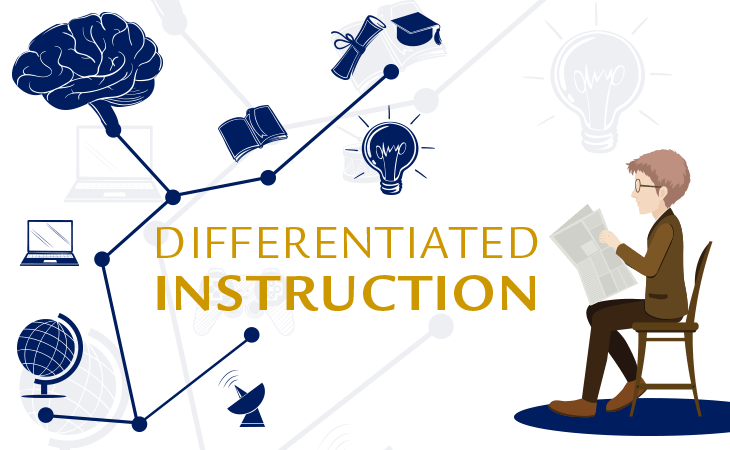
Classroom teaching traditionally has used one method of learning for all students in a classroom. While this way of teaching is efficient and can be effective, it does not benefit those students who may have a different learning style. Differentiated instruction enables teachers to accommodate the various learning needs of a group and provide individualized instruction.
About Differentiated Instruction
In differentiated instruction, teachers understand the different needs of students, such as by evaluating rate of learning, language proficiency, literacy and more. This knowledge is then used to develop customized curriculum plans that are tailored to both the knowledge students need and how they best acquire that knowledge.
Differentiated Instruction Strategies in the Classroom
While differentiated instruction can help students succeed, teachers must discern how to differentiate curriculum and learning activities without widening the achievement gap between students. Here are some differentiated instruction strategies that can help teachers effectively implement this model of learning.
On-the-spot-support
Teachers can provide one-on-one assistance to students during lessons so that they are able to complete the same learning activities and keep up with their peers, says Peter Westwood, author of What Teachers Need to Know About Differentiated Instruction.
Offer options
Another helpful strategy, shared by Edutopia, is to create folders with graphic organizers, visual aids and sentence starters so that teachers can easily tailor the learning experience to students. This is also a good diagnostic tactic, as teachers will be able to see whether the student completes a modified assignment with ease or continues to struggle.
Learning centers
According to TeachHub, learning centers provide students with ways to learn or practice skills on their own. They are stations that contain mini lessons or activities designed to be flexible and address the needs of diverse learners. Teachers can create learning centers at various skill levels and complexity, presenting the same information in a variety of different ways. Students engage with the material in a way that aligns with their proficiency.
Independent study
This strategy is ideal for students who have mastered content and are ready for more challenging work. Teachers can help them choose topics they are interested in and complete assignments designed just for them. Independent study is beneficial because it allows the student to learn at a faster pace and build self-confidence.
Tiered assignments
Teachers can also utilize tiered assignments, which are tasks that relate to each other but vary in difficulty. Depending on the skill level and readiness of students, they learn the same material as the rest of the class in a more accessible way. This could involve shorter texts, more group discussion or incorporating drawing versus writing. Tiered assignments can be designed for individuals or small groups.
Adjusted questions
This is a simple, straightforward way for teachers to differentiate. When asking questions during class discussion, teachers can adjust based on the students’ ability level. TeachHub recommends using Bloom’s Taxonomy to develop questions from more basic queries to advanced.
Differentiated rubrics
Teachers can also differentiate the rubrics used to evaluate student performance. Because modern classrooms include students with diverse learning needs and skill levels, different benchmarks are required. According to TeachingChannel, teachers can identify which rubric elements certain students should focus on, then divide them into groups to work on those areas together.
While the strategies above can help successfully implement differentiated instruction, there are other considerations, according to Scholastic.
- Ongoing, formative assessment: Teachers can evaluate students’ strengths and areas for improvement throughout the school year to help them progress.
- Recognition of diverse learners: When educators can identify students with diverse learning styles and expertise in reading, writing, problem-solving and other key competencies, they can better meet student needs.
- Group work: Assigning collaborative learning projects allows students to observe and learn from one another.
- Problem-solving: Focusing on concepts and “big ideas” as the central part of lessons enables students to explore topics in their own way, rather than focusing on memorization or learning by rote, which may be more difficult for some.
- Choice: Teachers in differentiated classrooms can give students a choice of what to read or write about. This helps to motivate students and appeal to their interests.
Teacher Education at King University
As inclusive education grows, so too does the need for effective differentiated instruction strategies in the classroom. Differentiated instruction, while an important tactic for student success, requires some education and expertise to do well. King University’s online Master of Education in Teacher Leaders degree program features coursework that focuses on inclusion and diversity in the classroom, as well as curriculum theory and instructional design. Graduates are better prepared to implement contemporary approaches to education, such as differentiation, and can help share this knowledge with others in their schools. Designed for teachers who are ready to become leaders and mentors, this program offers the advanced education required to become subject matter experts in the classroom and beyond. You can learn more about King University’s online teacher education program here.